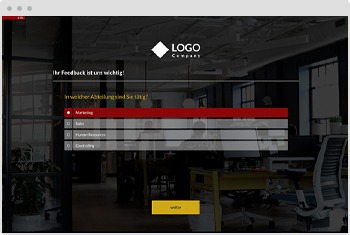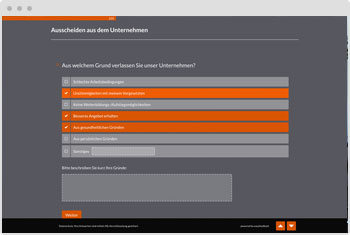Employee survey to increase employee satisfaction

With this ready-to-use survey template, you can measure and check satisfaction in your company and derive targeted measures from the results.

“Identifying customer needs is an essential part of our business. easyfeedback accompanies us for many years as a loyal partner in this task. We particularly appreciate the intuitive usability of the survey tool as well as the professional support.”
Guild Lead User Experience Research

“We use easyfeedback for internal and external surveys – fast, comfortable and really easy! Straightforward and cordial support can always create a smile. We really appreciate the permanent development of the platform.”
Guest & Competitor Insights Analyst
Content and targets of this employee satisfaction template
High employee satisfaction is a competitive advantage of innovative companies. Satisfied and motivated employees are more creative and innovative. Employee satisfaction creates room for ideas and promotes future company development.
Satisfied employees are productive employees . Team spirit and individually appropriate tasks motivate. Personal contact and open communication create a pleasant working atmosphere for colleagues and superiors.
Why not ask for feedback with an anonymous employee survey – annually and on special occasions. The feedback from your employees will help you to constantly improve.
Explore the current satisfaction and motivation of your employees and identify possible problems and weak points with our ready-to-use employee satisfaction survey template.
Content:
• Surveys on general employee satisfaction
• Identifying opportunities and providing targeted training
• Transparency of internal communication
• Assessment of management and supervisors
• Demographic data on length of service
Targets:
• Increase employee satisfaction and employee motivation
• Identifying weaknesses in communication
• Strengthening team spirit
• Innovation through better collaboration
• Strengthen attractiveness for the talents of the future

Data privacy protection „made in Germany“ (GDPR)

Anonymity functions for open feedback
Almost everything you need to know about employee satisfaction
1. What is employee satisfaction?
Employee satisfaction is the attitude of an employee towards his work and the employer, which is influenced by his experiences.
If the employee has a negative experience during his time with the company, this leads to an increase in dissatisfaction, which affects his motivation, his performance and his willingness to resign.
2. Why is employee satisfaction important for companies? Why should I measure it?
Aiming for high employee satisfaction makes sense for companies for various reasons.
One of the main arguments is that a satisfied employee is more committed and motivated. They perform better. This willingness to perform is reflected in the achievement of corporate goals and thus also in the success of the company.
Furthermore, satisfied employees are important ambassadors for a company’s employer brand. They are more likely to recommend their employer positively to friends and acquaintances.
Another argument why employee satisfaction is important for companies is the retention of existing staff and the avoidance of terminations due to dissatisfaction. In this way, companies avoid high fluctuation within the company and save costs incurred in finding and training personnel.
Measuring employee satisfaction is therefore important in order to record the current state in relation to the satisfaction of your employees. Because only if you know that your employees are not satisfied with you as an employer, with the corporate culture you live or with their work, do you have the opportunity to change something about it. Negative feedback can therefore help to improve your employer brand in the long term and promote positive corporate development.
3. What influences employee satisfaction?
Employee satisfaction is influenced by various factors, which can be divided into hygiene factors and factors that affect motivation.
1. Hygiene factors
This describes factors that result from the environment and are thus primarily extrinsic in nature. Examples of hygiene factors are working conditions, personal relationships among colleagues, employee management, leisure time activities, salary and more.
If these factors are not met, this leads to dissatisfaction.
2. Motivational factors
These factors arise from a person’s internal needs and the external factors of the work environment. Examples of these factors would be recognition, performance success, work tasks, taking responsibility, and more.
4. How can I measure employee satisfaction?
The best and easiest way to measure employee satisfaction is with a survey.
Using a questionnaire adapted to your company, you have the opportunity to ask your employees questions about their general satisfaction, working conditions, health or other important areas.
The following methodological approaches can help you to calculate key figures:
Employee Net Promoter Score (eNPS)
The eNPS is a metric that allows you to easily find out how loyal and connected employees are to your company. To do this, you simply ask employees how likely they are to recommend their company to friends or acquaintances on a scale of 0 – 10. A distinction is made here between the so-called promoters, who would recommend the employer, and the detractors, who would not.
Fluctuation rate
The fluctuation rate is a key figure that calculates how many employees have left the company in relation to the total workforce within a defined period of time. A distinction is made here between the voluntary and involuntary fluctuation rate
Absenteeism/sickness rate
Another key figure to get an indication of the current Employee Experience of your company is the sickness rate. It describes the percentage of the workforce that is unable to attend work due to illness. To a certain extent, it also reflects employee satisfaction.
5. How can you increase employee satisfaction?
There are many different ways to increase employee satisfaction. Below, we’ve put together a few helpful tips:
Tip 1: Obtain feedback regularly
You can only increase employee satisfaction if you know what your employees’ needs and wishes are and where there are problems. To do this, get feedback on a regular basis. This will give you a good indication of how you can increase employee satisfaction.
Tip 2: Work-life balance
Especially in times of increasing pressure to perform due to the steady rise in the shortage of skilled workers and increased digital networking among each other, the separation between work and private life has become increasingly difficult.
It is therefore important that employers offer their employees a healthy work-life balance and promote it through appropriate measures. This increases employee satisfaction immensely.
Tip 3: Create transparency and openness
There are many causes for intransparency in companies – first and foremost silo and competitive thinking. Of course, you don’t have to know every move made by every employee in every department.
But it is important to exchange information about plans and activities among each other and, in this context, to check whether there are overlaps and common interests.
Often, you don’t know what your colleagues in the same department are currently working on and whether these activities are perhaps relevant to you in one way or another.
A smooth flow of information within the company promotes employee satisfaction.
Tip 4: Promote continuous learning
Learning successes and new insights motivate because they create a sense of accomplishment on a subconscious level. And what could be better for companies than having highly motivated employees who love their jobs because they can develop and grow?
Tip 5: Allow for mistakes and failures
Of course, we (almost) all have an interest in performing well and being successful with our work. This factor is an essential part of employee satisfaction.
But when something doesn’t go right, it’s important to be able to talk about it transparently and openly, without fear of getting another lecture from your manager.
Mistakes happen. And that’s a good thing. Otherwise, you can’t learn from your mistakes.
6. What questions can I ask for an employee satisfaction survey?
Ask your employees how they see your company as an employer and whether they are satisfied with their job or their tasks. Depending on the survey project, different question approaches are possible here. We have listed some suggested questions below:
- How satisfied are you with us as an employer?
- How satisfied are you with your tasks?
- How satisfied are you with your salary?
- What is particularly important to you about an employer?
- Would you recommend us as an employer?
- How do you rate the career opportunities?
- Do you have any suggestions/criticisms/suggestions for improvement?
For more suggestions, feel free to take a look at our employee satisfaction survey template or simply create a survey yourself using the easyfeedback tool.
You are in professional company













